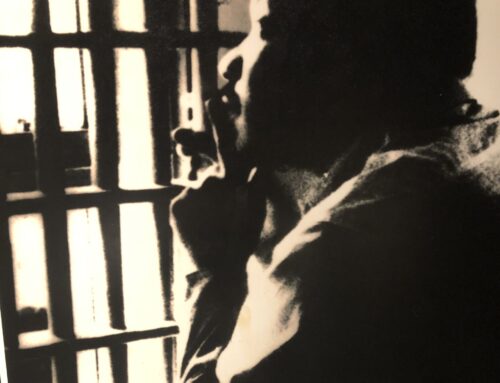
As Jesus’ body hung on the blood stained cross that he carried to Golgotha, the men closest to him for the previous three years were nowhere to be found. With the exception of John, we have no evidence that any of the disciples actually saw Jesus on the cross. These were men Jesus had specifically and personally invited to follow him. For three years, he lived with them, taught them the truth, showed them his power, and told them this day was coming. But they were not prepared.
The corrupt and powerful influence of both the religious leaders and Roman governor were too much for them. They hid in fear they would be next. Perhaps they doubted Jesus was who they thought he was. Maybe just raw confusion flooded their hearts.
But when Jesus’ closest disciples ran away, an unlikely man walked in.
“Joseph of Arimathea came, a prominent member of the Council, who himself was waiting for the kingdom of God; and he gathered up courage and went in before Pilate, and asked for the body of Jesus.” (Mark 15:43)
Joseph was a prominent and wealthy member of the Jewish politically elite council of the Sanhedrin. But somewhere along the way, he became a disciple of Jesus (Matthew 27:57). John described him as a “secret” disciple because of his fear of the Jews (John 19:38). He was known as a good and righteous man (Luke 23:50).
While the disciples scattered and the Jewish leaders conspired and the Roman leaders played the fool, Joseph stayed in the shadows. Maybe he was confused. Maybe he was afraid. Or maybe, like many of us, he was not exactly sure how to live out his faith in Jesus, the long expected Messiah.
But as the body of Jesus hung lifeless on the cross, something changed in Joseph. At the moment Jesus’ disciples lost their courage, Joseph found his. While Jesus’ inner circle hid, Joseph went public. While Jesus’ disciples looked for safety, Joseph served.
He “gathered up courage and went in before Pilate” (Mark 15:43) to offer his own family tomb for the body of Jesus. According to Jewish custom, Jesus’ body must be removed, prepared, and buried before sunset.
Why would he do that? Why would he come out of the closet now? Why would he risk association with a dead man accused, tried, and executed for treason? Why would he risk his position of influence for a man who apparently had nothing else to offer?
Some may say Joseph believed Jesus would be raised from the dead. Maybe that is true. Maybe his understanding of the Scripture was clear enough for him to see just that. Maybe Joseph knew he would get his tomb back. But maybe it was something else. Maybe God does something profound with slow faith, even secret faith.
I’m not suggesting God honors our lack of faith. Jesus rebuked his disciples for that. But maybe big faith, powerful faith, the no nonsense kind of faith takes more time to grow than we might expect. We all remember Peter’s enthusiasm. Who doesn’t love Peter? But Peter taught us that enthusiasm is not always enough. Transforming faith is a faith built on a relationship with Jesus. It is firmly rooted in the soil of the Gospel. And the deepest roots take time to take hold.
There are no best selling books on slow faith. I have never been to a conference on how to build slow faith. But Joseph of Arimathea shows us at least four reasons we may want to give slow faith a second chance:
Slow faith is sober faith.
Few, if any, of the disciples looked at the broken body of Jesus. They did not watch him hoisted in the air. They did not see him struggle to breath. They did not see him bleed out. They did not see him bear the weight of their sin and the sins of the world. But I think Joseph was there and I think he saw it all. He watched Jesus, who knew no sin, become sin on his behalf, and as a result his slow faith picked up speed.
Slow faith is authentic faith.
Joseph made the effort to care for the broken body of Jesus that no one expected him to make. He showed loyalty to the man his peers rejected. There was no foreseeable upside to his actions, yet he did it. Like Mary who poured oil on Jesus’ head, Joseph’s extravagance was not an act of dignity, but of uncommon and unmistakable devotion.
Slow faith is working faith.
The body of the crucified seldom had a proper burial. Yet Joseph took the initiative and offered his own tomb for Jesus’ body. But that is not all he did. With the help of others, he removed, cleaned, wrapped, and buried Jesus’ body. It was messy. It was time consuming and it was costly. Slow faith is not lazy faith or merely theoretical faith. It is a working faith.
Slow faith is courageous faith.
No one had more to lose than Joseph. Sure, he could have lost his life like the rest of the disciples. But unlike the others, Joseph had wealth, power, and prominence. He likely had a wife, children, and maybe grandchildren to think about. Yet with so much to lose, Joseph buried the body of Jesus. Slow faith produces courage that is willing to take risks, suffer loss, and accept criticism.
Gospel transformation is immediate, but the results are not always immediately visible. Sometimes the faith God produces in us is slow, or even secret, for a period of time. So when we get frustrated with our own weak faith, we should take heart. God is working. And when we are tempted to lose patience with others who are not as bold in the faith as we might expect, we may want to back off and let God work in them in His time just as He has is us.
Joseph was slow, but he became strong. Joseph was slow, but he became sure. And by the grace of God, he even got his tomb back and his slow faith became sight.
Feel free to click “comments” and share your personal story of slow faith.




